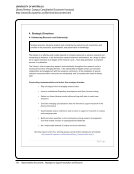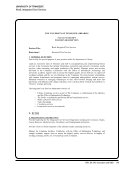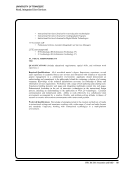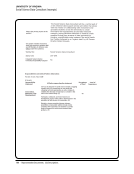SPEC Kit 339: Innovation and R&D · 17
by a special request by the library director, and a re-
quest included in the library annual/periodic budget.
Research &Development: Assessment
Assessment is clearly important to the 22 libraries
(73%) that have evaluated the success of specific R&D
projects, and the seven that plan to. Twenty-six of
those libraries (90%) collect and analyze data on the
use of the project’s services or products (or will do
so). Other assessment methods include interview-
ing individuals or focus groups who use the product
or service, and user surveys. However, most of the
respondents (25 out of 29) stated that they had not
assessed or evaluated the utility of R&D activities
overall, although eight said that they planned to. The
planned assessment processes ranges from very rigor-
ous to informal.
Twenty-seven libraries described how the library
determines that a project should move from an ex-
perimental to production service. In just more than
half of the cases, library administration makes the
decision to move forward. Others noted that a project
might be moved forward to production on a case-by-
case basis, or that user demands are what drive the
decision. One of the comments deserves highlighting
because it points to the importance of agility:
“I like to instill the values of lean startup—in this
manner measurements and metrics are built into
the process. We try to use more of an agile ap-
proach—adapting based on use and other insights
[from] which the idea, product, or service is be-
ing developed. I think the waterfall approach of
launch and then wait-and-see assessment does not
translate to “innovation” so that’s why I selected
“No” to the questions about assessment. Most of
our R&D does not “assess ” instead, we build/
measure/learn we constantly adapt and pivot.”
Futurecasting and Conclusions
The final set of survey questions asked respondents to
indicate what role they thought innovation will play in
their library’s future. Forty libraries responded to this
open-ended question with their perspectives on the
role of innovation in the library’s future. Many respon-
dents indicated that innovation would play an im-
portant role in the future, most citing that innovation
would be “critical to maintaining the alignment of the
library’s mission with the needs and the work of its
user communities.” One respondent views innovation
as the “heart of planning for the future.” Other com-
ments focused on the fact that innovation in libraries
was increasing as libraries move from a print to digital
economy, where the pace of change is fast, and user
demands can change quickly, requiring libraries to
anticipate new demands before they are fully formed.
Several respondents believe that innovation is impor-
tant for libraries as they identify new ways to partner
with faculty and to support their research needs. One
respondent expressed doubts about the future of inno-
vation activities, stating that “…library administration
wants to be 100% sure that something will work before
they give the go-ahead.” While innovative activities
signal risk-taking in an organization, the underlying
structure that most libraries have built into support
for innovation—case-by-case decision-making, and
assessment—appears to moderate the risk associated
with innovation.
When asked who would be their innovative part-
ners in the next 1 to 3 years, respondents articulated a
number of potential partnerships within and beyond
their institutions. Many expressed the desire for the li-
brary to become engaged with faculty in partnerships
that supported subject domain and interdisciplinary
research, including data curation and management,
scholarly publishing, digitization, and access. Others
articulated interest in working with faculty and stu-
dents on digital learning, instructional technology
development, and developing deeper partnerships
around teaching, learning, and library support. A
number of respondents anticipate partnering with the
Office of Research on research policy, support, data
curation, and management. Working with campus
IT is also anticipated.
Although the overwhelming majority of the re-
sponding libraries consider innovation and R&D to
be a crucial element in the library’s ability to antici-
pate and support evolving user needs, they do not
anticipate creating a line item in the library budget to
support innovation per se. Only nine of the respon-
dents (26%) indicated that R&D has a likelihood of be-
coming a line item in the library’s budget in the near
future. This could be because so many respondents
by a special request by the library director, and a re-
quest included in the library annual/periodic budget.
Research &Development: Assessment
Assessment is clearly important to the 22 libraries
(73%) that have evaluated the success of specific R&D
projects, and the seven that plan to. Twenty-six of
those libraries (90%) collect and analyze data on the
use of the project’s services or products (or will do
so). Other assessment methods include interview-
ing individuals or focus groups who use the product
or service, and user surveys. However, most of the
respondents (25 out of 29) stated that they had not
assessed or evaluated the utility of R&D activities
overall, although eight said that they planned to. The
planned assessment processes ranges from very rigor-
ous to informal.
Twenty-seven libraries described how the library
determines that a project should move from an ex-
perimental to production service. In just more than
half of the cases, library administration makes the
decision to move forward. Others noted that a project
might be moved forward to production on a case-by-
case basis, or that user demands are what drive the
decision. One of the comments deserves highlighting
because it points to the importance of agility:
“I like to instill the values of lean startup—in this
manner measurements and metrics are built into
the process. We try to use more of an agile ap-
proach—adapting based on use and other insights
[from] which the idea, product, or service is be-
ing developed. I think the waterfall approach of
launch and then wait-and-see assessment does not
translate to “innovation” so that’s why I selected
“No” to the questions about assessment. Most of
our R&D does not “assess ” instead, we build/
measure/learn we constantly adapt and pivot.”
Futurecasting and Conclusions
The final set of survey questions asked respondents to
indicate what role they thought innovation will play in
their library’s future. Forty libraries responded to this
open-ended question with their perspectives on the
role of innovation in the library’s future. Many respon-
dents indicated that innovation would play an im-
portant role in the future, most citing that innovation
would be “critical to maintaining the alignment of the
library’s mission with the needs and the work of its
user communities.” One respondent views innovation
as the “heart of planning for the future.” Other com-
ments focused on the fact that innovation in libraries
was increasing as libraries move from a print to digital
economy, where the pace of change is fast, and user
demands can change quickly, requiring libraries to
anticipate new demands before they are fully formed.
Several respondents believe that innovation is impor-
tant for libraries as they identify new ways to partner
with faculty and to support their research needs. One
respondent expressed doubts about the future of inno-
vation activities, stating that “…library administration
wants to be 100% sure that something will work before
they give the go-ahead.” While innovative activities
signal risk-taking in an organization, the underlying
structure that most libraries have built into support
for innovation—case-by-case decision-making, and
assessment—appears to moderate the risk associated
with innovation.
When asked who would be their innovative part-
ners in the next 1 to 3 years, respondents articulated a
number of potential partnerships within and beyond
their institutions. Many expressed the desire for the li-
brary to become engaged with faculty in partnerships
that supported subject domain and interdisciplinary
research, including data curation and management,
scholarly publishing, digitization, and access. Others
articulated interest in working with faculty and stu-
dents on digital learning, instructional technology
development, and developing deeper partnerships
around teaching, learning, and library support. A
number of respondents anticipate partnering with the
Office of Research on research policy, support, data
curation, and management. Working with campus
IT is also anticipated.
Although the overwhelming majority of the re-
sponding libraries consider innovation and R&D to
be a crucial element in the library’s ability to antici-
pate and support evolving user needs, they do not
anticipate creating a line item in the library budget to
support innovation per se. Only nine of the respon-
dents (26%) indicated that R&D has a likelihood of be-
coming a line item in the library’s budget in the near
future. This could be because so many respondents
































































































































































































